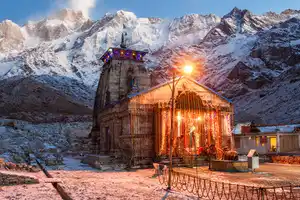Kedarnath Temple: The Abode of Shiva
Home » Kedarnath Dham »
 Sitting majestically and comfortably by the holy river of Mandakini is one of the holiest and ancient temples of India. The actual date of the creation of this temple is unknown but sage Shankaracharya has been credited with reviving this holy place. Along with being a crucial part of the Chota char dham yatra of Uttarakhand Kedarnath dham is also one of the most pious jyotirlingas and also one of the 275 Paadal Petra Sthalams which is spread across the Indian subcontinent. Sitting at an elevation of 11,755 feet above sea level and surrounded by an unmatched and bountiful natural beauty, the temple cannot be accessed directly however it can only be covered after covering a trekking journey of almost 11 to 14 kms of trekking journey. During the peak pilgrimage seasons which usually occur during the summer or early winter months, this temple attracts a number of tourists from far and wide seeking for salvation. The entire route to Kedarnath is dotted with thick and thriving forests making the journey extremely scenic and you won’t be able to feel the tiredness. There are numerous alternate travel options available like pony rides, helicopter journey, Doli rides and more which will help you in completing the holy journey.
Sitting majestically and comfortably by the holy river of Mandakini is one of the holiest and ancient temples of India. The actual date of the creation of this temple is unknown but sage Shankaracharya has been credited with reviving this holy place. Along with being a crucial part of the Chota char dham yatra of Uttarakhand Kedarnath dham is also one of the most pious jyotirlingas and also one of the 275 Paadal Petra Sthalams which is spread across the Indian subcontinent. Sitting at an elevation of 11,755 feet above sea level and surrounded by an unmatched and bountiful natural beauty, the temple cannot be accessed directly however it can only be covered after covering a trekking journey of almost 11 to 14 kms of trekking journey. During the peak pilgrimage seasons which usually occur during the summer or early winter months, this temple attracts a number of tourists from far and wide seeking for salvation. The entire route to Kedarnath is dotted with thick and thriving forests making the journey extremely scenic and you won’t be able to feel the tiredness. There are numerous alternate travel options available like pony rides, helicopter journey, Doli rides and more which will help you in completing the holy journey.
Legend:
According to a popular mythological account it was believed that Kedarnath was the holy residence of Lord Shiva after consistent request from Nar – Narayan. After the conclusion of the great war of Mahabharat sage Vyas advised the pandava brothers to go and meet Lord Shiva and ask him for forgiveness since they had killed their kin the Kauravas. The story goes ahead to mention that Lord Shiva was in no mood to forgive them and transformed himself into a bull. He also hid himself by sinking head first into the ground. Bhim, the strongest of the pandava brothers then immediately grabbed the bull’s tail and started pulling him to make him forcefully appear before them. Due to this Lord Shiva’s bull form got divided and appeared at the sites of panch kedar. The earliest mention for kedarnath is seen in the Skanda purana which is a holy Hindu book that marks the origin of the holy river Ganga.
Another interesting legend revolves around Nar and Narayan – two of the most popular incarnations of Lord Vishnu. It is believed that Nar and narayan had performed some rigorous penance here with an earthen shiv lingam at Bharat Khand. Lord Shiva was extremely pleased with their penance and appeared before them and asked them for a boon. They asked him to stay permanently at Kedarnath in the form of a jyotirlinga. Hearing this, the lord agreed to fulfill their wishes and enshrined himself in the form of a jyotirlinga above which the main dham shrine of Kedarnath was constructed.
Architecture:
The date of construction for this holy temple is alleged to be dated back to almost 1000 years ago. The temple follows the basic construction rules and adheres to a general architectural plan. The temple is divided into two distinct sections called garbha griha and mandap. The garbha griha part of the temple while in the Mandapa is a spacious section which accommodates huge turnouts of pilgrims and devotees. The entire temple structure is created using heavy and massive stone slabs which is still a wondrous creation keeping in mind that it was built in yesteryears. The overall temple structure sits on top of a rectangular platform. Standing as a guard to the temple is a structure of Nandi the bull who is believed to be the vehicle of Lord Shiva. The inner walls of this temple are adorned with engravings dedicated to various mythological deities and other mythical scenes.
Inside The Temple:
The image of the presiding deity inside the temple is in the form of a black triangular stone in an irregular form. This irregular lingam sits on a pedestal which is 12 feet in circumference and 12 feet in height. The moment you enter the temple you will be ushered into a small pillared hall which contains images of goddess Parvati and the five pandava brothers. The very first hall inside the temple contains statues dedicated to Lord Krishna, Nandi the bull, Virabhadra along with the five pandava prices. A statue of Draupadi also graces the insides of the temple. It is believed that sage Shankaracharya, who is known to have revived this temple, had attained his Mahasamadhi at Kedarnath itself. A Samadhi dedicated to this legendary saint was constructed later on right behind the main temple of Kedarnath.


Leave a Reply